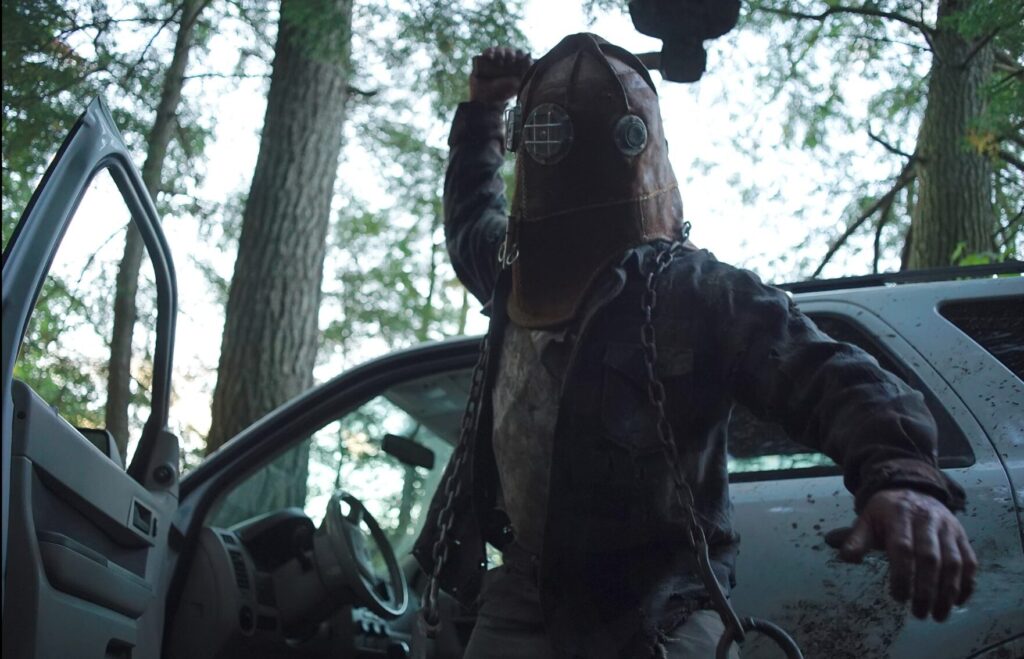“In a Violent Nature” Turns the Slasher Up to Eleven

Of all horror’s many sub genres, the slasher may be king. Since a boom in the 80s, we’ve seen the genre evolve through the years. From iconic foundations like Halloween and A Nightmare on Elm Street through modern evolutions like Scream, Freddy vs. Jason, and Freaky, horror creatives have been hacking away at the tried and true formula. Chris Nash’s In a Violent Nature pushes the concept forward once again in an ultraviolet film with the killer at center stage. This ingenious twist proves to be not only a gory bit of horror filmmaking, but a new exploration of one of horror’s most beloved tentpoles.
We begin on the forest floor with a close shot of a dangling necklace inside an abandoned shack. When a group of reckless college students take the mysterious locket, they inadvertently awaken an evil presence buried deep underground. A killer we will come to know as Johnny (Ry Barrett) begins slowly stalking a nearby campground, brutally dispatching anyone who gets in his way. Hoping to track down his shiny token, Johnny targets these unfortunate kids and one by one marks them for gruesome death. As we learn more about this supernatural foe, we wonder if anything can stop his violent rampage.
Rather than a final girl and her ill-fated friends, Nash’s film follows the killer himself. Once Johnny has risen from the earth, we follow several feet behind as he plods through the woods in search of the necklace connecting him to the memory of his mother. Nash offers an interesting twist on traditional POV shots perfected in Carpenter’s Halloween and keeps our focus squarely on Johnny. Other characters drift in and out of the frame, giving us just enough information to piece together his backstory and identify themselves as potential victims.
The film wears its influences on its sleeve. With nods to The Burning and My Bloody Valentine, Johnny and his forest domain feel like a reinvention of Jason Voorhees. In fact watching this ultra-gory film feels much like playing Friday the 13th the Game as the machete-wielding killer. We drift through contained scenarios as he plots his course, chooses his weapons, and targets his prey. Other actors feel like non-playable characters occasionally delivering strategic exposition. An excellent sound design presents diegetic conversation and sound, fully immersing us in the killer’s world. Gorgeous cinematography holds boredom at bay as we marvel at the juxtaposition of this gruesomely decaying killer in the midst of lush nature.
The title hints at the film’s strongest component: up-close sequences of extreme violence. Traditional slashers often soft-pedal the killer’s violent tendencies with off-screen deaths only revealed in the aftermath of the kill. But following the villain, we become privy to intimate details of these extended deaths. We see the gruesome dismemberments and slowly unfolding decapitations as they occur. Occasionally veering into torture porn territory, Nash seems to be rubbing our noses in the brutal details and has saved most of his miniscule budget for special effects. Simultaneously grotesque and exhilarating, some sequences may overwhelm even hardcore horror fans.
While the performances are strong, particularly that of final girl Kris (Andrea Pavlovic), humanity isn’t really the point. This cast full of relative newcomers faithfully recreates long-standing slasher archetypes with intriguing details thrown in along the way. Johnny is a solid antagonist and manages to capture our interest with miniscule moments, but his humanism isn’t really the point either. We’re focused on his decaying body and the violence of his horrific actions, not his strength as a relatable character. He is a human animal occupying a violent world and his grisly actions speak more than any dialogue ever could.
After an incredible first hour, the film takes an interesting shift in the final act. As we learn more about Johnny’s targets, the focus begins to gradually shift toward their experience. Following the concept to its logical conclusion, this turn is admittedly frustrating and may leave viewers wanting, but you kind of have to admire Nash’s commitment to the bit. Refusing to let us off the hook with a linear narrative, In a Violent Nature is a high-concept approach to a familiar story that feels simultaneously shocking and new.
Jenn Adams is a writer, podcaster, and film critic from Nashville, TN. Find her social media nonsense @jennferatu.